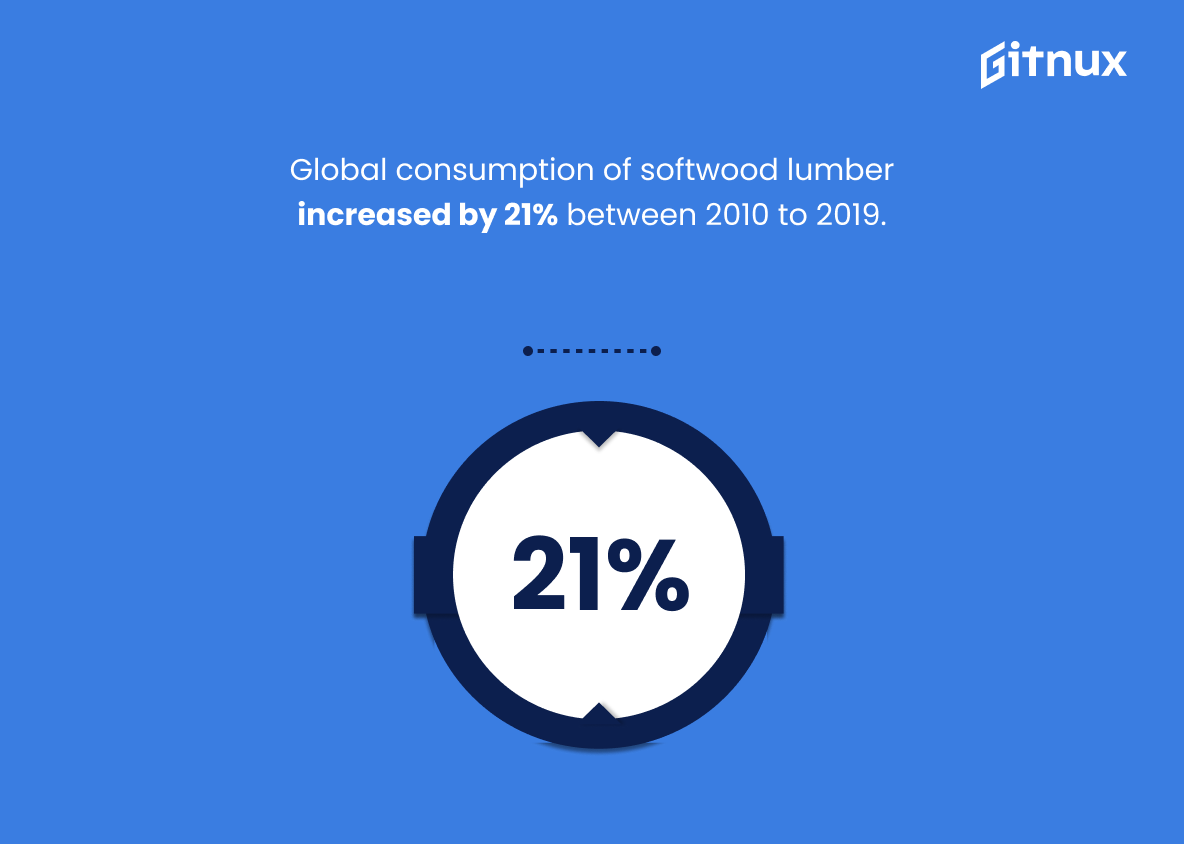The lumber industry is an important part of the global economy, with a market size valued at USD 56.37 billion in 2020 and generating $67 billion in the United States alone that same year. In 2024, global lumber trade is expected to reach approximately 122 million cubic meters while Russia was the largest exporter of lumber in 2020 with 29 million cubic meters exported. China imported 43.3 million cubic meters of lumber making it the world’s largest importer and there were 2,132 sawmills operating within U.S borders as recently as 2018. Canada supplied 64% of U.S imports while Eastern European production increased by 17%. Global softwood production reached 436 million cubic meters compared to 155 for hardwoods; however employment declined due to automation and globalization trends over time from 2001-2020 resulting in 42% fewer jobs than before this period began.. 278 thousand acres were harvested for Canadian timber production during 2019 while Sweden achieved record high levels reaching 20 7million cubit metres also that year . The total added value generated by wood processing industries across Europe amounted to 55 billion euros whilst Brazilian exports rose 58 percent between 2016-2019 31 Million Cubic Metres worth of Timber products were imported into EU countries 2021 , Softwood Lumber prices hit all time highs May 2021 & US consumption 54 1 Billion Board Feet respectively . Finally Indonesia’s processed wood product exports totalled 11 6 Billion Dollars 2019
This statistic is a testament to the immense size of the lumber market, highlighting its importance in the global economy. It serves as a reminder of the vast potential of the lumber industry and the opportunities it presents for businesses and investors alike. Furthermore, it provides a benchmark for measuring the growth of the lumber industry over time.
The lumber industry in the United States generated $67 billion in 2019.
This statistic is a testament to the immense economic impact of the lumber industry in the United States. It highlights the importance of the industry in terms of its contribution to the nation’s GDP and its role in providing jobs and economic stability. It also serves as a reminder of the importance of sustainable forestry practices and the need to protect our forests for future generations.
Lumber Industry Statistics Overview
In 2020, China imported approximately 43.3 million cubic meters of lumber, making it the world’s largest importer.
This statistic is a testament to the immense demand for lumber in China, making it the world’s largest importer. It highlights the importance of the lumber industry in the global economy and the need for sustainable forestry practices to meet the growing demand. This statistic is a key indicator of the lumber industry’s success and its potential for growth in the future.
The total number of sawmills in the United States in 2018 was 2,132.
This statistic is a key indicator of the health of the lumber industry in the United States. It provides insight into the number of businesses that are actively producing lumber, which can be used to gauge the overall demand for lumber products. Additionally, it can be used to compare the number of sawmills in the US to other countries, providing a better understanding of the global lumber market.
In 2019, Canada was the largest supplier of lumber to the U.S., supplying 64% of U.S. imports.
This statistic is a testament to the strength of the Canadian lumber industry, as it demonstrates that Canada is the leading supplier of lumber to the U.S. This is significant because it shows that Canada is a reliable source of lumber for the U.S., and that the lumber industry in Canada is thriving. This is important information for anyone interested in the lumber industry, as it provides insight into the current state of the industry and the potential for growth.
The Eastern European lumber production increased by 17% between 2019 and 2020.
This statistic is a testament to the Eastern European lumber industry’s resilience and growth in the face of adversity. It shows that despite the challenges of 2020, the industry was able to make significant strides in production, indicating a strong and healthy future.
In 2019, the global production of softwood lumber reached 436 million cubic meters, while hardwood lumber production stood at 155 million cubic meters.
This statistic is a telling indication of the lumber industry’s current state. It reveals that softwood lumber production is significantly higher than hardwood lumber production, indicating that softwood is the more popular choice among consumers. This statistic is important for understanding the current trends in the lumber industry and can be used to inform decisions about future investments and production.
Employment in the U.S. lumber and wood production industry declined by approximately 42% from 2001 to 2020, reflecting automation and globalization trends.
This statistic is a stark reminder of the impact of automation and globalization on the U.S. lumber and wood production industry. It highlights the need for the industry to adapt to the changing landscape and to find ways to remain competitive in the global market. This statistic is an important piece of information for anyone interested in the lumber industry, as it provides insight into the current state of the industry and the challenges it faces.
In 2019, approximately 278,000 acres of forest land were harvested in Canada for lumber production.
This statistic is a telling indication of the scale of the lumber industry in Canada. It demonstrates the sheer amount of forest land that is being harvested to meet the demands of the lumber industry, and the impact this has on the environment. It is a stark reminder of the importance of sustainable forestry practices in order to ensure the longevity of the industry.
In 2021, the total U.S. lumber consumption reached approximately 54.1 billion board feet.
This statistic is a testament to the immense demand for lumber in the United States. It highlights the importance of the lumber industry in the country and the need for sustainable practices to ensure that the industry can continue to meet the needs of the population.
The forestry and logging sub-sector contributed 0.19% to Canada’s GDP in 2020.
This statistic is a telling indication of the importance of the forestry and logging sub-sector to Canada’s economy. It demonstrates that, despite the challenges posed by the pandemic, the lumber industry still managed to make a significant contribution to the country’s GDP. This highlights the resilience of the sector and its importance to the Canadian economy.
Global consumption of softwood lumber increased by 21% between 2010 to 2019.
This statistic is a testament to the growth of the lumber industry over the past decade. It shows that the demand for softwood lumber has increased significantly, indicating that the industry is thriving and that more people are turning to lumber as a building material. This is an important statistic to consider when discussing the lumber industry, as it provides insight into the industry’s success and potential for further growth.
Conclusion
The global lumber industry is a multi-billion dollar market that has seen significant growth in recent years. The total value of the global lumber market was estimated to be USD 56.37 billion in 2020, and it is expected to grow by an additional USD 24.14 BN over the next four years. In 2019, the U.S., Canada, Russia and China were some of the largest producers and exporters of lumber products worldwide while Europe imported 31 million cubic meters worth of timber and timber products from other countries in 2021 alone. Additionally, softwood lumber prices have reached record highs due to increased demand for wood materials across various industries such as construction and manufacturing sectors globally. As automation trends continue to reduce employment opportunities within this sector, it will be interesting to see how these changes affect future production levels around the world going forward into 2022 and beyond
References
0. – https://www.srs.fs.usda.gov
1. – https://www.50.statcan.gc.ca
2. – https://www.luke.fi
3. – https://www.usforestry.maps.arcgis.com
4. – https://www.globalwoodmarketsinfo.com
5. – https://www.timber-online.net
6. – https://www.nrcan.gc.ca
7. – https://www.bls.gov
8. – https://www.comtrade.un.org
9. – https://www.statista.com
10. – https://www.globenewswire.com










